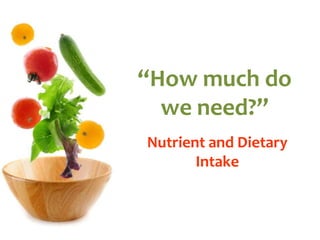
How much do we need?
- 1. “How much do we need?” Nutrient and Dietary Intake
- 2. Dietary Reference Intakes For Teenagers Refer to the table provided Highlight any observations you make that are particularly intriguing and/or surprising to you. In your groups, compare and discuss your findings; be prepared to share with the larger group. Note: You may want to refer to your notes from the previous unit on vitamins and nutrients.
- 3. Think Where are we going to get enough of these nutrients that we need everyday to sustain our health? By eating foods as our source of energy and nutrients. How much should we be eating in order to get these required nutrients? We need to consume a certain number of calories in order to get the required nutrients.
- 4. CALORIC INTAKE Calorie: the amount of energy produced when food is oxidized or consumed by the body. The number of calories your body needs varies based on a number of factors: Activity level Age Weight Height Gender Kcal = kilocalorie 1 food calorie 1000 energy calories
- 5. CALORIES = ENERGY The minimum amount of energy required to maintain basic life functions is referred to as the BASAL METABOLIC RATE (BMR). Accounts for 60-70% of calories burned in a day and includes the energy required to keep the heart beating, the lungs breathing, eyelids blinking and body temperature stabilized Higher in men than in women Consuming too few calories will not allow for the basic BMR levels to be maintained; starvation and death will follow Consuming too many calories forces the body to store the excess as fat
- 7. A Few Things to Consider… Obese and overweight people require a negative calorie balance burn more calories that they consume Caloric intake decreases as we age. Carbohydrates and proteins provide 4 calories per gram. Fat provides 9 calories per gram. 55% of calories should come from carbs. 12-15% of calories should come from proteins. Less than 30% of calories should come from fat.
- 11. Nutrition-Related Deaths 54% starvation, protein malnutrition 1% iodine deficiency 5% vitamin A deficiency 28% iron deficiency, anemia 12% other
- 12. “How much do we need?” Dietary Reference Intakes
- 13. Everyone needs the same nutrients but not the same amounts. Females need more iron than males Active people need more of most nutrients than sedentary people Seniors require less of many nutrients Pregnant women require folic acid
- 14. What is the D.R.I.? Introduced in 1997, Dietary Reference Intakes helps North Americans stay healthy. It is updated every 5 years. Outlines the number of servings from each of the food groups recommended in order to consume appropriate amounts of each nutrient.
- 15. What is the D.R.I. composed of? Estimated Average Requirements (EAR) Expected to meet the needs of 50% of the people in an age group Recommended Dietary Allowances (RDA) Nutrient-intake levels for 97-98% of people at each stage of life; 20% higher than EAR Adequate Intake(AI) Where there are is no RDA Tolerable Upper-Intake Levels (UL) Cautions against excessive intake of nutrients that can be harmful in large amounts